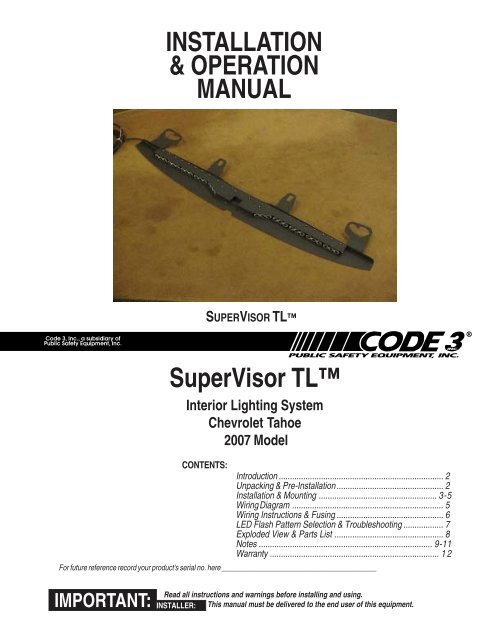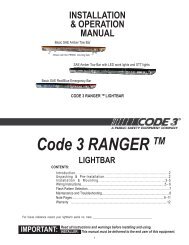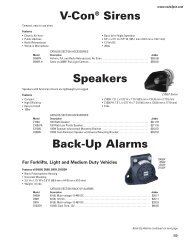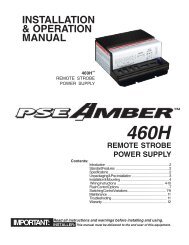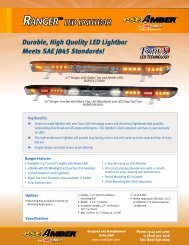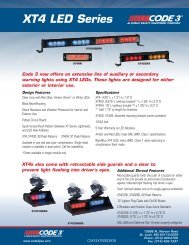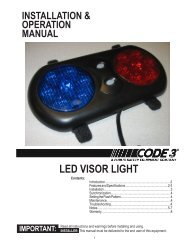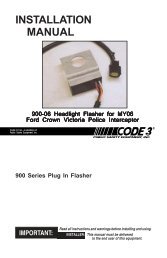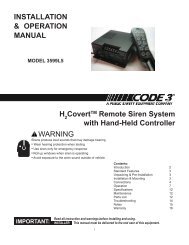SuperVisorTL for 2007 Chevy Tahoe Installation Guide
SuperVisorTL for 2007 Chevy Tahoe Installation Guide
SuperVisorTL for 2007 Chevy Tahoe Installation Guide
Create successful ePaper yourself
Turn your PDF publications into a flip-book with our unique Google optimized e-Paper software.
INSTALLATION& OPERATIONMANUALSUPERVISOR TLSuperVisor TLInterior Lighting SystemChevrolet <strong>Tahoe</strong><strong>2007</strong> ModelCONTENTS:Introduction .......................................................................... 2Unpacking & Pre-<strong>Installation</strong>................................................ 2<strong>Installation</strong> & Mounting ..................................................... 3-5Wiring Diagram .................................................................... 5Wiring Instructions & Fusing ................................................ 6LED Flash Pattern Selection & Troubleshooting .................. 7Exploded View & Parts List ................................................. 8Notes .............................................................................. 9-11Warranty ............................................................................ 1 2For future reference record your product's serial no. here __________________________________________IMPORTANT:Read all instructions and warnings be<strong>for</strong>e installing and using.INSTALLER: This manual must be delivered to the end user of this equipment.
IntroductionThe SuperVisor TL is an interior lighting system that fits in the visor area near the top of the windshield. It delivers an amazing warningsignal. The SuperVisor TL is designed on a modular basis, which means that the lightbar can be customized to meet most anyrequirements. The SuperVisor TL has room <strong>for</strong> up to ten LED lightheads. Each lighthead is individually wired <strong>for</strong> any flash pattern orcombination of flash patterns required.!WARNING!The use of this or any warning device does not ensure that all drivers can or will observe or react to an emergencywarning signal. Never take the right-of-way <strong>for</strong> granted. It is your responsibility to be sure you can proceed safelybe<strong>for</strong>e entering an intersection, driving against traffic, responding at a high rate of speed, or walking on or aroundtraffic lanes.The effectiveness of this warning device is highly dependent upon correct mounting and wiring. Read and followthe manufacturer’s instructions be<strong>for</strong>e installing or using this device. The vehicle operator should insure daily that allfeatures of the device operate correctly. In use, the vehicle operator should insure the projection of the warningsignal is not blocked by vehicle components (i.e.: open trunks or compartment doors), people, vehicles, or otherobstructions.This equipment is intended <strong>for</strong> use by authorized personnel only. It is the user’s responsibility to understand andobey all laws regarding emergency warning devices. The user should check all applicable city, state and federallaws and regulations.Code 3, Inc., assumes no liability <strong>for</strong> any loss resulting from the use of this warning device.Proper installation is vital to the per<strong>for</strong>mance of this warning device and the safe operation of the emergencyvehicle. It is important to recognize that the operator of the emergency vehicle is under psychological and physiologicalstress caused by the emergency situation. The warning device should be installed in such a manner as to:A) Not reduce the output per<strong>for</strong>mance of the system, B) Place the controls within convenient reach of the operatorso that he can operate the system without losing eye contact with the roadway.Emergency warning devices often require high electrical voltages and/or currents. Properly protect and use cautionaround live electrical connections. Grounding or shorting of electrical connections can cause high current arcing,which can cause personal injury and/or severe vehicle damage, including fire.Any electronic device may create or be affected by electronmagnetic interference. After installation of any electronicdevice operate all equipment simultaneously to insure that operation is free of interference. Never power emergencywarning equipment from the same circuit or share the same grounding circuit with radio communicationequipment.PROPER INSTALLATION COMBINED WITH OPERATOR TRAINING IN THE PROPER USE OF EMERGENCYWARNING DEVICES IS ESSENTIAL TO INSURE THE SAFETY OF EMERGENCY PERSONNEL AND THEPUBLIC.All devices should be mounted in accordance with the manufacturer's instructions and securely fastened to vehicleelements of sufficient strength to withstand the <strong>for</strong>ces applied to the device. Driver and/or passenger airbags (SRS)will affect the way equipment should be mounted. This device should be mounted by permanent installation andwithin the zones specified by the vehicle manufacturer, if any. Any device mounted in the deployment area of an airbag will damage or reduce the effectiveness of the air bag and may damage or dislodge the device. Installer mustbe sure that this device, its mounting hardware and electircal supply wiring does not interfere with the air bag or theSRS wiring or sensors. Mounting the unit inside the vehicle by a method other than permanent installation is notrecommended as unit may become dislodged during swerving, sudden braking or collision. Failure to followinstructions can result in personal injury.Unpacking & Pre-installationCarefully remove the SuperVisor TL and place it on a flat surface, taking care not to scratch the lenses or damage the cable comingout of the side. Examine the unit <strong>for</strong> transit damage, broken lamps, etc. Report any damage to the carrier and keep the shipping carton.Standard lightbars are built to operate on 12 volt D.C. negative ground (earth) vehicles. If you have an electrical system other than 12volt D.C. negative ground (earth), and have not ordered a specially wired lightbar, contact the factory <strong>for</strong> instructions.Test the unit be<strong>for</strong>e installation. To test, touch the black wire to the ground (earth) and the other wires to +12 volts D.C., in accordancewith the instructions attached to the cable (an automotive battery is preferable <strong>for</strong> this test). Some units may be factory wired <strong>for</strong> controlby an LED flasher in which case the cable's wire tag should be consulted. A battery charger may be used, but please note that someelectronic options (flashers, stingrays, etc.) may not operate normally when powered by a battery charger. If problems occur at this point,contact the factory.2
WARNING! !Utilizing non-factory supplied screws and/or mounting brackets and/or the improper numberof screws may result in loss of warranty coverage on the equipment.Mounting Hardware - All mounting hardware is packed in a small box inside the main carton. There are four brackets used to mount theSupervisor TL to the vehicle. These are discussed in detail later.Step 1-Removing Sun VisorsBegin the installation by removing the driver and passenger sun visors. Identify each visor with tape or other marking to indicate the driverfrom the passenger side unit; they are not always identical. First remove the plastic visor pivot bracket cover by prying the cover apart atthe thin slit shown in Figure 1 with a thin instrument like a putty knife. There are small keeper tabs which hold the cover to the pivot bracket(Figure 2 shows the locations of the tabs). You have to pry the slit open and pull the cover down and away from the headliner at the sametime. It helps to pull the edge of the cover outward and down in the area of each tab to help release the cover from the pivot bracket. Whenone of the tabs is released, it is easier to release the cover at the other tab locations (Figure 3 shows the cover removed). Next there arethree screws that hold the pivot arm bracket of the sun visor to the headliner. Remove the three screws using a small #15 torx screwdriveras shown in Figure 4. The screws do not have to be completely removed from the plastic pivot arm bracket to release the pivot arm (seeFigure 5). Unplug the visor vanity mirror light wire if the vehicle is so equiped (see Figure 6).FIGURE 1 FIGURE 2 FIGURE 3FIGURE 4 FIGURE 5 FIGURE 6Step 2 Remove the visor retaining clipsPry open the small cover on the sun visor retaining clip with a very small flat bladed screwdriver to gain access to the sun visor retaining clipscrew (see FigureS 7 and 8). Remove the single #15 torx screw that holds each clip in place as shown in Figure 9.FIGURE 7 FIGURE 8 FIGURE 93
FIGURE 19 FIGURE 20 FIGURE 21The bracket fasteners make excellent hard mountingpoints <strong>for</strong> radar guns and video cameras etc.Caution: Drilling into the housing of the lightbar coulddamage wiring or other internal components.5
Wiring Instructions!WARNING!Larger wires and tight connections will provide longer service life <strong>for</strong> components. For high current wires it ishighly recommended that terminal blocks or soldered connections be used with shrink tubing to protect theconnections. Do not use insulation displacement connectors (e.g. 3M ® Scotchlock type connectors). Routewiring using grommets and sealant when passing through compartment walls. Minimize the number of splices toreduce voltage drop. High ambient temperatures (e.g. underhood) will significantly reduce the current carryingcapacity of wires, fuses, and circuit breakers. Use "SXL" type wire in engine compartment. All wiring shouldcon<strong>for</strong>m to the minimum wire size and other recommendations of the manufacturer and be protected from movingparts and hot surfaces. Looms, grommets, cable ties, and similar installation hardware should be used toanchor and protect all wiring. Fuses or circuit breakers should be located as close to the power takeoff points aspossible and properly sized to protect the wiring and devices. Particular attention should be paid to the locationand method of making electrical connections and splices to protect these points from corrosion and loss ofconductivity. Ground terminations should only be made to substantial chassis components, preferably directly tothe vehicle battery. The user should install a fuse sized to approximately 125% of the maximum Amp capacity inthe supply line to protect against short circuits. For example, a 30 Amp fuse should carry a maximum of 24Amps. DO NOT USE 1/4" DIAMETER GLASS FUSES AS THEY ARE NOT SUITABLE FOR CONTINUOUSDUTY IN SIZES ABOVE 15 AMPS. Circuit breakers are very sensitive to high temperatures and will "false trip"when mounted in hot environments or operated close to their capacity.Route the wiring cable into the passenger compartment down the door post as shown in Figure 22 or as otherwise desired. It isadvisable to leave an extra loop of cable when installing the lightbar to allow <strong>for</strong> future changes or reinstallations. Connect the blacklead to a solid frame ground (earth), preferably, the (-) or ground (earth) side of the battery, and the remaining power wires to the+12V terminal of the battery, power switches, siren or RLS controller. Each lighthead is wired independently to allow completeflexibility of control.FIGURE 22LED Fusing ConsiderationsAlthough the average current draw per module is very low, due to the type of circuit used to power each module, the instantaneouspeak current to a module can be significantly higher during low voltage conditions. To avoid prematurely blowing ATO style fuses ortripping breakers it is recommended the following rule-of-thumb be used to size fuses or breakers. This is especially important inlightbars with many LED modules running off a single fused source.Minimum fuse size calculation: (See Wiring Diagram page 5)For LED 12 volt electrical current only.5 X (number of 3-LED modules being fused) = Total Electrical Current at 12.8 VDCProduct Features3-LED Optix lighthead options:Size: 50.00" long x 1.54" tall x 5.25" deepWeight: 7.5 lbsRed, Blue, Amber, White;Directional, Wide or Hybrid Optics;Flashing or Steady Burn ControlWARNING!!This Product contains high intensity LED devices. To prevent eye damage, DO NOT stare intolight beam at close range.6
Directional Module Flash PatternFlash PatternCycle FlashSteady-BurnFive FlashQuad FlashTriple FlashDouble FlashFast Double FlashNFPAQuad Pop FlashTriple Pop FlashDescriptionCycles through various patterns @ 70 fpmSteady-BurnFive Pulses per flash @ 70 fpmFour Pulses per flash @ 70 fpmThree Pulses per flash @ 70 fpmTwo Pulses per flash @ 70 fpmTwo Pulses per flash @ 85 fpmFour Pulses, 70% Duty Cycle @ 75 fpmFour Pulses per flash ( 3 equal, 1 extended) @ 70 fpmThree Pulses per flash ( 2 equal, 1 extended) @ 70 fpmMomentarily short and releaseto change patternsJ1PCBFlash Pattern Header <strong>for</strong> OPTIX/LED XTroubleshootingAll SuperVisor TLs are thoroughly tested prior to shipment. However, should you encounter a problem during installation or during thelife of the product, follow the guide below <strong>for</strong> in<strong>for</strong>mation on repair and troubleshooting. Additional in<strong>for</strong>mation may be obtained from thefactory technical help line at 314-996-2800.Follow the guide below <strong>for</strong> in<strong>for</strong>mation on repair and troubleshooting.TROUBLESHOOTING GUIDENote: LED modules must be replaced as a module. There are no user serviceable parts.PROBLEMQUESTIONSPOSSIBLE CAUSESOLUTIONLED module notoperating whenpowered.N/Aa. Bad power/groundconnection.b. Defective module.a. Fix connection.b. Replace module7
Parts ListReference Number Part Description Part Number1 *LED Module *Contact Code 3, Inc <strong>for</strong> P/N2 Chassis T147203 Outer Panel T147214 Inner Mtg. Brkt. <strong>Tahoe</strong> T147195 Outer Mtg. Brkt. <strong>Tahoe</strong> Pass Side T147186 Outer Mtg. Brkt. <strong>Tahoe</strong> Drivr Side T147178
Notes9
Notes10
Notes11
WARRANTYCode 3, Inc.'s emergency devices are tested and found to be operational at the time of manufacture. Provided theyare installed and operated in accordance with manufacturer's recommendations, Code 3, Inc. guarantees all parts andcomponents except the lamps to a period of 1 year, LED Lighthead modules to a period of 5 years (unless otherwiseexpressed) from the date of purchase or delivery, whichever is later. Units demonstrated to be defective within the warrantyperiod will be repaired or replaced at the factory service center at no cost.Use of lamp or other electrical load of a wattage higher than installed or recommended by the factory, or use ofinappropriate or inadequate wiring or circuit protection causes this warranty to become void. Failure or destruction of theproduct resulting from abuse or unusual use and/or accidents is not covered by this warranty. Code 3, Inc. shall in no waybe liable <strong>for</strong> other damages including consequential, indirect or special damages whether loss is due to negligence or breachof warranty.CODE 3, INC. MAKES NO OTHER EXPRESS OR IMPLIED WARRANTY INCLUDING, WITHOUTLIMITATION, WARRANTIES OF FITNESS OR MERCHANTABILITY, WITH RESPECT TO THIS PRODUCT.PRODUCT RETURNSIf a product must be returned <strong>for</strong> repair or replacement*, please contact our factory to obtain a Return GoodsAuthorization Number (RGA number) be<strong>for</strong>e you ship the product to Code 3, Inc. Write the RGA number clearlyon the package near the mailing label. Be sure you use sufficient packing materials to avoid damage to the productbeing returned while in transit.*Code 3, Inc. reserves the right to repair or replace at its discretion. Code 3, Inc. assumes no responsibility or liability <strong>for</strong> expenses incurred <strong>for</strong> the removal and /orreinstallation of products requiring service and/or repair.; nor <strong>for</strong> the packaging, handling, and shipping: nor <strong>for</strong> the handling of products returned to sender after the service has beenrendered.NEED HELP? Call our Technical Assistance HOTLINE - (314) 996-2800Code 3®, Inc.10986 N. Warson RoadSt. Louis, Missouri 63114-2029—USAPh. (314) 426-2700 Fax (314) 426-1337www.code3pse.comCode 3 is a registered trademark of Code 3, Inc. a subsidiary of Public Safety Equipment, Inc.Revision 0, 11/06 - Instruction Book Part No. T14722©2006 Public Safety Equipment, Inc. Printed in USA12


